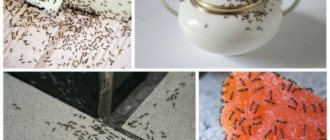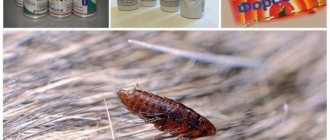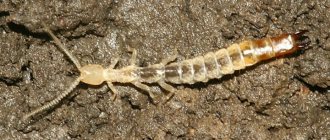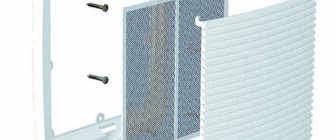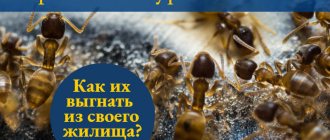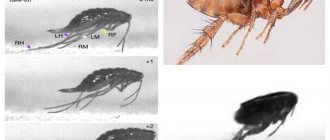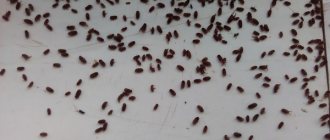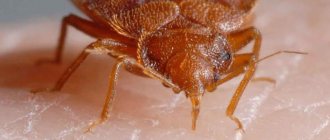Description
The bread ground beetle is one of the most common representatives of the order of Coleoptera insects, which make up the largest family of beetles (about 50,000 species):
- adults grow up to 2.5 cm;
- have an oval-shaped convex body, painted black with a slightly pronounced metallic tint;
- the surface of the abdominal part of the beetle is brown in color.
The insect has resinous-black thread-like antennae and 5-segmented limbs. The convex elytra have relatively deep, finely punctuated grooves. The beetle has strong and at the same time blunt jaws at the ends. The ground beetle is pictured below.
Bread ground beetle
Description of the insect:
The beetle,
14-16 mm long, is pitch-black with a faint metallic sheen.
Convex elytra with nine stripes. Posterior quarter of pronotum with rough points. Antennae, tibiae and tarsi are brownish-red; the fore tibiae are widened and equipped with a strong spine. The egg
is 2 mm in size, oval, white, glossy.
The larva
is off-white, the head and three thoracic segments are dark brown;
light brown spots are visible on the abdominal segments above; the abdomen ends in two processes. The pupa
is yellowish, with clearly visible legs and wings, and is placed in an earthen cocoon.
Lifestyle and habitat
The ground beetle is nocturnal, hiding during the day in its shelter (under snags, stones or tree roots). If a ground beetle has settled in a house, it usually hides in the joints of old furniture.
In natural conditions, the favorite habitat of the ground beetle is fields of winter wheat, rye, barley, oats and even corn.
On a note!
The pest gnaws the scales of the ear, damaging the primordia of the grains and the already ripening grain. In the absence of grain crops, the beetle can satisfy its hunger even with leeks.
What are the benefits of ground beetles in the garden, how to attract ground beetles
Ground beetles eat harmful garden insects, caterpillars, snails and slugs, which destroy homestead and garden crops. The common ground beetle is the simplest, most natural and environmentally friendly way to combat these pests. That is, if there are a lot of ground beetles, then you can do without chemicals and preparations to combat garden pests. And thus get a clean harvest and avoid unnecessary expenses on chemical protection.
The ground beetle saves the harvest by destroying mature pests and, in fact, preventing them from reproducing. Meanwhile, not all chemicals work equally well at different stages of pest development, and this is why it is necessary to do several sprayings per season.
Therefore, these orderly bugs do not need to be destroyed, but on the contrary, it is advisable to increase their population in the area. If the question is how to quickly attract more ground beetles to your garden or garden, then, firstly, you need to create habitats for them. To do this, leave on the site pieces of tree bark, piles of leaves, sawdust, small stones - anything that will serve as a refuge for the beetles. And secondly, if possible, do not use chemicals to control pests. Ground beetles are sensitive to chemicals, which also have a detrimental effect on them.
Those who feed on the ground beetles themselves are birds, but they do this infrequently due to one feature of the beetles. When in danger (as well as to immobilize prey), the beetles secrete an unpleasant substance, so birds try to avoid ground beetles.
Reproduction
In the presence of favorable conditions of heat and humidity, bread ground beetles begin to actively mate, after which the females lay eggs (from 50 to 250 pieces) in the soil. Dry weather reduces the fertility of ground beetles.
Insect reproduction After 10-15 days, larvae are born and remain in the soil until frost occurs. They spend the winter there, building a shelter for themselves in the form of a hole. They resume feeding on winter crops until the pupation period. It takes about 3 weeks to form a pupa. One generation of beetles appears per year.
Features of bread ground beetle
The ground beetle is otherwise called the humpbacked peon. The beetle's natural habitat is fields with crops.
A horde of corn ground beetles on the wall
It is very rare to see peun in residential buildings.
Bugs prefer those habitats where the lowest soil temperature in the cold season does not fall below -3 degrees. Usually these are the southern steppe zones.
Appearance
Ground beetles in general are a very large family of arthropods. About three thousand species are known in our country alone.
The humpback peon has distinctive features, although in appearance it is very similar to other representatives of this family.
The ground beetle has medium dimensions - the body of an adult reaches 2.5 cm in length. It is convex, thick, with grooved elytra.
Bread ground beetle on a leaf
Color – rich black. Like a typical representative of Coleoptera, the paeon's forewings are rigid and hard, with caraboid venation.
The head of this ground beetle is weakly retracted into the chest and ends with blunt massive jaws, ideally suited for plant food.
Unlike most members of the family, the humpback peon is not a predator. However, it is precisely this fact that makes the beetle an enemy of farmers, since the grain ground beetle significantly spoils crops and infects grain.
Life cycle and reproduction
The characteristic type of development for the bread beetle beetle is complete metamorphosis.
This means that the insect goes through the following stages of development: egg, larva, pupa and adult.
It takes a long time for the bread ground beetle to transform from an egg into a sexually mature individual.
Mating occurs in the warm season, and the female lays several dozen eggs in the soil in August.
The mating process of bread ground beetles
The masonry is located underground at a depth of about 10 cm.
After about 2 weeks, larvae emerge from the eggs. They are able to overwinter, continuing to develop after the soil thaws.
Corn ground beetle larva
The larvae of the humpbacked peon are weakly hairy, with a black head, dark brown in color with a lighter belly.
They live in a hole in the upper soil layer near a plant suitable for food. At night, the larvae leave their shelter to feed, and during the day they can pull leaves underground.
In places of their mass accumulation, serious damage is caused to the grain harvest: leaves and stems of cereals are their main food.
Pupation occurs closer to May; this stage lasts for 2-3 weeks. Adults develop just in time for winter crops to form grain. At night, beetles eat it away. In this case, a lot of grain is simply knocked out of the ear by insects and falls to the ground.
One generation of humpbacked beetles develops per year, but even this fact is disappointing for grain growers: during the period of its life, the beetle spoils a lot of grain.
The ground beetle eats cereal crops
Wheat, barley and rye are the favorite delicacies of ground beetles, but in the absence of such, corn, leeks, and oats are also used.
Where do bugs come from?
A ground beetle can find its way into an apartment in the following ways:
- beetle larvae can be carried into the house on shoes;
- together with products: cereals, flour or potatoes;
- with wood for lighting a fireplace or heating a stove;
- An unpleasant odor and remains of animal food in a pet’s cage can attract the attention of insects;
- Considering that beetles always fly towards the light, they enter the house through windows not protected by mosquito nets.
When night comes, a pest that has crawled into the house goes in search of food, which can be cereals, as well as crumbs and leftover food left on the table. With its rustling sound, the beetle deprives you of sleep and rest, often falling from the ceiling onto the bed. If the insect’s attempt to get food is successful, then this is a favorable signal for reproduction. Therefore, when a ground beetle appears in the house, it is necessary to take urgent measures to combat it.
Prevention
Prevention measures directly depend on the reasons for the appearance of these pests in the house. After all, it is much better to look for an answer to the question of how to prevent ground beetles from appearing in your home than to think about the problem: “There is a ground beetle in the apartment, how to get rid of it?”
Regular cleaning of the apartment is a guarantee that various uninvited guests will not appear in it. If you plan to bring old furniture or other wooden objects into the apartment, they must be inspected in advance and treated with special means - insecticides. If you don’t have these in your arsenal, you can use regular baking soda or vinegar.
Cereals, potatoes, flour are places of increased danger. They should be carefully inspected after purchase. It is best to sort and wash the potatoes and cereals, sift the flour and seal it tightly.
Considering that bread ground beetles most often enter the house through open windows, it is worth considering installing mosquito nets. In addition, they will protect not only from annoying bugs, but also from other unpleasant insects.
How to get rid of bugs in an apartment
Destruction of beetles in the house It is quite simple to destroy the malicious pest of the fields.
- Before you get rid of ground beetles in your apartment, you first need to find the place where they live. Then do a general cleaning, placing all bulk products in sealed containers.
- To treat the habitat of bread beetles, you can use a vinegar or soda solution, or use insecticidal agents such as Dichlorvos, Karbofos or Fufanon.
- If cereals or flour are infected with ground beetles, it is preferable to get rid of them completely. If this is not possible, the products should be calcined in the oven for 20-30 minutes.
- You can also fight bread beetles using ultraviolet rays by heating contaminated products in the sun for 6 hours.
- Cold has no worse effect on pests. Air temperatures below 15 degrees are detrimental to insects.
- Use baits based on boric acid.
- Plants with a strong aroma can also fight the uninvited guest. These are cloves, garlic, bay leaf.
How to deal with bread ground beetle
If crops are attacked by ground beetles, control measures should include not only baiting the beetle and larvae, but also preventing the mass spread of insects.
Harvesting from the field
To achieve this, it is important to harvest the crop promptly and quickly, reducing grain loss, to peel the stubble, and to plow with skimmers.
Carrion seedlings where the beetle may be hiding should be destroyed. In the spring, in order to identify ground beetles, soil excavations are carried out: in an area measuring 50 by 50 cm, a layer of soil is removed to a depth of 30 cm, and the number of insect larvae discovered in this way is counted. Such samples are taken in a checkerboard pattern with the calculation: 16 excavations per 100 hectares.
In case of uniform infestation of the field, insecticides are used to treat the pest. If the infestation is minor, selective baiting will do.
During the period of grain ripening, ears are inspected for the presence of peuns early in the morning or late in the evening. Insecticides are used if more than 10 individuals are detected in an area of 1 square meter.
Chemicals
Before sowing, cereal seeds are treated with the drug “Imidalit”, this is a pesticide with complex effects that has a detrimental contact and intestinal effect on a number of harmful insects, including the ground beetle.
The active ingredients, imidacloprid and bifenthrin, are selected in optimal concentrations and have virtually no effect on people.
Chemical agent "Imidalit"
Imidalide does not cause allergies, is not toxogenic, is used sparingly, and is compatible with other pesticides.
To bait corn ground beetles during the growing season, use the product “Clonrin”.
Chemical agent "Clonrin"
It is a pesticide based on cypermethrin and clothanidin. Clonrin acts quickly and effectively, maintaining a protective effect for a long period after treatment, and does not have a harmful effect on crops or people.
Traditional methods
If ground beetles have settled in a barn or residential building, it is not necessary to use toxic drugs in such a small area.
Will help:
- “fragrant” plants placed around the perimeter of the room: wormwood, garlic, tansy, cloves;
- You can put nails in bulk products and flour - the taste of metal will drive away the pest;
- If the food is contaminated and you don’t want to throw it away, you can bake it in the oven at high temperature.
Preventive measures for the beetle include:
- storing products in inaccessible places in sealed containers;
- installing mosquito nets on windows in the warm season;
- regular wet cleaning.
How to protect crops on the field
The following methods will help you get rid of bread ground beetles from crop areas:
- Follow the rules of crop rotation.
- Harvest grain crops at early stages of ripening. Moreover, you should immediately remove straw from the field and plow the soil to a depth of at least 20 cm.
- Attract natural enemies: various parasitic and predatory insects.
- Use treated seeds for sowing. Spray young crops with insecticidal preparations in a timely manner.
- Use insecticides Aktara, Eforia, Cruiser during the period of active feeding of the larvae.
Preparations used to protect grain crops from ground beetles
| Manufacturer | Name | Active ingredients | Consumption rate | Price per liter/kg | Availability |
| Insecticide AKTARA, VDG | 250 g/kg thiamethoxam | 19417 | |||
| Insecticide EFORIYA, KS | 106 g/l lambda-cyhalothrin, 141 g/l thiamethoxam | 5405 | |||
| Insecticide CONFIDOR EXTRA, VDG | 700 g/kg imidacloprid | 0.03 - 0.45 kg/ha | 15491 | ||
| Insecticide PROTEUS, MD | 100 g/l thiacloprid, 10 g/l deltamethrin | 2422 | |||
| Insecticide TANREC, VRK | 200 g/l imidacloprid | 3420 | |||
| Insecticide SHARPEY, ME | 250 g/l cypermethrin | 1539 | |||
| Insecticide ENLIL, CE | 600 g/l diazinon | 2166 | |||
| Insecticide Mospilan, RP | 200 g/kg acetamiprid | 0.06 - 0.7 kg/ha | 7781 | ||
| Insecticide Superkill, EC | 500 g/l chlorpyrifos, 50 g/l cypermethrin | 0.6 l/ha | 1392 | ||
| Insecticide Regent, VGD | 800 g/l fipronil | 0.02 - 0.03 kg/ha | 42000 |
Means of struggle
In the case of this type of pest, there are several ways to destroy it. Prevention of reproduction is to prevent rapid reproduction of the ground beetle. To do this, it is enough to remove its power source as much as possible. To understand how important such events are, it is worth comparing: with a sufficient amount of food, the female lays about 120 eggs, and without it - only 30. Therefore, after the harvest, it is worth clearing the field as quickly as possible from stubble, in which females can lay eggs, and fallen grain , which can germinate. Before sowing winter crops, treat the soil using deep plowing. It’s better to leave the field where the grain was growing fallow or plant other crops.
Pre-sowing chemical treatment. It consists of processing grain intended for winter crops. The seed is treated with insecticides such as “Cruiser”, which destroy the larvae.
Spraying crops. The leaves of young plants and the soil around them are processed. Control agents are insecticides “Norton”, “Aktara”, “Ephoria” and others. They affect both larvae and adults.
The common ground beetle is one of the most studied species. And there are still a lot of little-known representatives of the family and those that humanity has yet to recognize.
Appearance
The length of an adult reaches 12–18 mm. The beetle has a number of characteristic features:
- oval body shape;
- the color is dark, resinous in color with a metallic tint;
- the jaws are powerful and blunt at the ends. They allow the ground beetle to gnaw through the hard shell of the plant and get to the juicy pulp;
- clearly visible antennae covered with bristles;
- relatively long, adapted for rapid movement of the legs. Characteristic notches are noticeable on the front legs, with the help of which ground beetles clean their antennae;
- the elytra almost completely cover the abdomen.
It is noteworthy that the size of the wings depends on the amount of food. If the ground beetle is comfortable, there is no need to migrate; the wings become shorter.
